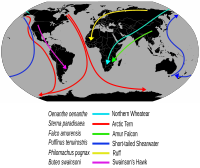
Photo from wikipedia
Background The timing of migration for herbivorous migratory birds is thought to coincide with spring phenology as emerging vegetation supplies them with the resources to fuel migration, and, in species… Click to show full abstract
Background The timing of migration for herbivorous migratory birds is thought to coincide with spring phenology as emerging vegetation supplies them with the resources to fuel migration, and, in species with a capital breeding strategy also provides individuals with energy for use on the breeding grounds. Individuals with very long migration distances might however have to trade off between utilising optimal conditions en route and reaching the breeding grounds early, potentially leading to them overtaking spring on the way. Here, we investigate whether migration distance affects how closely individually tracked Eurasian wigeons follow spring phenology during spring migration. Methods We captured wigeons in the Netherlands and Lithuania and tracked them throughout spring migration to identify staging sites and timing of arrival. Using temperature-derived indicators of spring phenology, we investigated how maximum longitude reached and migration distance affected how closely wigeons followed spring. We further estimated the impact of tagging on wigeon migration by comparing spring migratory timing between tracked individuals and ring recovery data sets. Results Wigeons migrated to locations between 300 and 4000 km from the capture site, and migrated up to 1000 km in a single day. We found that wigeons migrating to more north-easterly locations followed spring phenology more closely, and increasingly so the greater distance they had covered during migration. Yet we also found that despite tags equalling only around 2% of individual’s body mass, individuals were on average 11–12 days slower than ring-marked individuals from the same general population. Discussion Overall, our results suggest that migratory strategy can vary dependent on migration distance within species, and even within the same migratory corridor. Individual decisions thus depend not only on environmental cues, but potentially also trade-offs made during later life-history stages.
Journal Title: Movement Ecology
Year Published: 2021
Link to full text (if available)
Share on Social Media: Sign Up to like & get
recommendations!